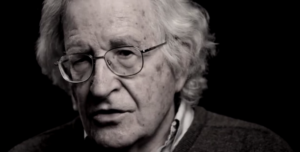Chomsky: Maintaining Class Inequality At Any Cost Is GOP’s Guiding Mission
The Republican Party has been steadily moving toward the extremely reactionary end of the scale over the past several decades. In some ways, Trump simply accelerated and finally cemented the GOP’s transition into an anti-democratic, proto-fascist political organization — although the Trump phenomenon is, in other ways, singular in political history, and its impact on U.S. politics and society will undoubtedly be felt for many years to come.
In the interview that follows, world-renowned scholar and public intellectual Noam Chomsky offers a tour-de-force analysis of the evolution of the U.S. political setting and the vital role that class warfare and repression have played in making corporate culture the dominant force, turning American society into a neoliberal dystopia. Chomsky also sheds light on why today’s GOP has turned U.S. politics into a culture war battle while pursuing policies that suppress social rights and strangle intellectual freedom, with Viktor Orbán’s “racist Christian nationalist proto-fascist government … hailed as the ideal for the future.” In addition, he assesses the political situation in connection with the passage of the Inflation Reduction Act.
Chomsky is institute professor emeritus in the department of linguistics and philosophy at MIT and laureate professor of linguistics and Agnese Nelms Haury Chair in the Program in Environment and Social Justice at the University of Arizona. One of the world’s most-cited scholars and a public intellectual regarded by millions of people as a national and international treasure, Chomsky has published more than 150 books in linguistics, political and social thought, political economy, media studies, U.S. foreign policy and world affairs. His latest books are The Secrets of Words (with Andrea Moro; MIT Press, 2022); The Withdrawal: Iraq, Libya, Afghanistan, and the Fragility of U.S. Power (with Vijay Prashad; The New Press, 2022); and The Precipice: Neoliberalism, the Pandemic and the Urgent Need for Social Change (with C.J. Polychroniou; Haymarket Books, 2021).
C.J. Polychroniou: Noam, the Republican Party has become an unabashedly anti-democratic political organization steering the U.S. toward authoritarianism. In fact, most GOP voters continue to support a political figure that sought to overturn a presidential election and seem to be enamored with Hungary’s strongman Viktor Orbán, who dismantled democracy in his own country. It is also of little surprise the way Republicans have responded to the FBI raid on Mar-a-Lago. The rule of law is of no consequence to them, yet conservatives charge that it is the Democrats who are moving the country toward authoritarianism. What’s shaping the character of the current Republican Party?
Noam Chomsky: What is unfolding before our eyes is a kind of classical tragedy, the grim conclusion foreordained, the march toward it seemingly inexorable. The origins are deep in the history of a society that has been free and bountiful for the privileged, awful for those who were in the way or cast aside.
A century ago, a stage was reached that has some similarity to today. In his classic study, The Fall of the House of Labor, labor historian David Montgomery writes that in the 1920s “corporate mastery of American life seemed secure.… Rationalization of business could then proceed with indispensable government support.” Inequality was soaring, along with corruption and greed. The vibrant labor movement had been crushed by Woodrow Wilson’s Red Scare, after decades of violent repression.
“Modern America had been created over its workers’ protests,” Montgomery continued, “even though every step in its formation had been influenced by the activities, organizations, and proposals that had sprung from working class life.” In the late 19th century, it seemed possible that the Knights of Labor, with its demand that those who work in the mills should own them, might link up with the radical farmers movement, the Populists, who were seeking a “cooperative commonwealth” that would free farmers from the tyranny of northeastern bankers and market managers. That could have led to a very different America. But it could not withstand state-corporate repression and violence.
A few years after the fall of the house of labor came the Great Depression. The labor movement revived and expanded, moving to large-scale industrial organization and militant actions. Crucially, there was a sympathetic administration, and a lively and often radical political environment. All of this laid the basis for the New Deal reforms that enormously improved American life and had repercussions in European social democracy.
The business world was split. Thomas Ferguson’s research shows that capital-intensive internationally oriented business accepted New Deal policies, while labor-intensive domestically oriented business was bitterly opposed. Their publications warned ominously of the “hazard facing industrialists” from labor action backed by “the newly realized political power of the masses,” topics explored in depth in Alex Carey’s Taking the Risks out of Democracy, which inaugurated the study of corporate propaganda.
As soon as the war ended, the business world launched a major assault on labor. It was impressive in scale, ranging from forced indoctrination sessions for the workforce even to taking over sports leagues. This was all part of the project of “selling free enterprise,” while the salesmen were happily gorging at the public trough where the hard and creative work of constructing the new high-tech economy was on the account of the friendly taxpayer.
Violent repression was no longer adequate to restoring the glory days of the ‘20s. More subtle means of indoctrination were devised, including “scientific methods of strike-breaking,” by now honed to a high art with the support of administrations since Reagan that barely pay attention to such labor laws as still exist.
The business campaign was expedited by the attack on civil liberties called “McCarthyism,” which led to expulsion of many of the most effective labor activists and organizers. Unions entered into a compact with capital to gain benefits for members (though not the public) in return for abandoning any significant role on the shop floor.
The regimented capitalism of the early postwar years has been called the “golden age of [state] capitalism,” with high and egalitarian growth. By the mid-‘60s popular activism was beginning to expose some of the long-concealed record of American history, and addressing some of its brutal legacy, again with the cooperation of a sympathetic administration.
By the early ‘70s, the established social order was tottering under the impact of the “Nixon shock” that undermined the postwar Bretton Wood system, stagflation, and not least, the growing threat of the popular movements that were civilizing the society. Elite concerns are well attested by major publications bracketing the mainstream spectrum of opinion.
At the left-liberal end, the liberal internationalists of the Trilateral Commission released their first publication, The Crisis of Democracy. The political flavor of the Commission is illustrated by the fact that the Carter administration was drawn largely from its ranks. The “Crisis” that concerned them was the activism of the ‘60s, which was mobilizing people to press their concerns in the political arena. These “special interests,” as they are called, were imposing too many pressures on the state, causing a crisis of democracy. The solution they recommended is more “moderation in democracy” by the special interests: minorities, women, the young, the old, workers, farmers, in short, the population, who are to be “spectators” not “participants,” in accord with liberal democratic theory (Walter Lippmann, Harold Lasswell, Reinhold Niebuhr, and other distinguished figures).
Unspoken is a crucial premise: the “special interests” are to be “put in their place,” as Lippmann advised, so that ample room is left for the “national interest” that is upheld by the “masters of mankind,” Adam Smith’s term for the business classes, who shape national policy so that their own interests are “most peculiarly attended to.” Smith’s words, which resonate loudly today.
Of particular concern to the Trilateral liberals were the failures of the institutions responsible “for the indoctrination of the young,” particularly the schools and universities. That’s why we see young people protesting for civil rights, women’s rights, ending a criminal war of aggression, and other diversions from the proper course of passivity and conformism. Here, too, a change of course is necessary for a proper social order to be sustained, tasks that were attended to in due course.
Another concern was the media, out of control and adversarial, threatening “democracy” by raising too many questions. The Commission advised that state intervention might be necessary to overcome this crisis.
That is how “the time of troubles” was perceived at the left end of the mainstream spectrum. At the right end, positions were much harsher. The most important example is the Powell Memorandum, submitted to the Chamber of Commerce by corporate lawyer (later Supreme Court Justice) Lewis Powell. Written in apocalyptic terms, the Memorandum is a call to arms to the business world to defend the “American economic system” and “The American political system of democracy under the rule of law,” all “under broad attack” in a manner unprecedented in American history. The attack is so powerful that the very survival of the economic system and political democracy is at stake, as “no thoughtful person can question.”
Powell recommends that business rise from its traditional passivity and take strong measures to counter this “massive assault upon its fundamental economies, upon its philosophy, upon its right to continue to manage its own affairs, and indeed upon its integrity.”
The business world can easily take such measures, Powell reminds it. It holds the wealth of the country and largely owns the institutions that are bent on destruction of the business world, and American democracy and freedom with it.
The measures he outlines range widely. Thus “There should be no hesitation to attack the Naders and the Marcuses and others who openly seek destruction of the system. … Perhaps the single most effective antagonist of American business is Ralph Nader, who — thanks largely to the media — has become a legend in his own time and an idol of millions of Americans.” The left that dominates the media is so incorrigible as to commend Nader’s efforts to make cars safer, an outrageous attack on our fundamental values.
Scarcely less dangerous is Herbert Marcuse, with his enormous sway over the college campuses. These far-left bastions are “graduating scores of bright young men who despise the American political and economic system” and who then move into media and government, institutions from which business and advocates of “free enterprise” are virtually barred. As every “business executive knows, few elements of American society today have as little influence in government as the American businessmen, the corporation, or even the millions of corporate stockholders” (who the left falsely believes are skewed toward the wealthy).
In this case Powell at last provides evidence, not just rants from rightwing screeds: “Current examples of the impotency of business, and of the near-contempt with which business’s views are held, are the stampedes by politicians to support almost any legislation related to ‘consumerism’ or to the ‘environment’,” scare quotes for these absurd concoctions of the raging left.
It’s not just the college campuses that must be “cured” of the pathology of despising everything American. The same holds for media, particularly TV, which must be carefully monitored and “kept under constant surveillance … in the same way that textbooks should be.” The monitoring should be carried out by neutral and independent advocates of the American way, as determined by the business world. It is of highest importance to monitor “the daily ‘news analysis’, which so often includes the most insidious type of criticism of the enterprise system.”
Business has remained silent as this “assault on the enterprise system … has gradually evolved over the past two decades.” The innocents in corporate headquarters never even dreamt of developing programs to “sell free enterprise,” contrary to what scholarship documents in extensive detail.
The harshly oppressed business community will find it “difficult to compete with an Eldridge Cleaver or even a Charles Reich for reader attention,” or with the “ultraliberal Jack Newfield, who wrote in the journal New York that the root need in our country is ‘to redistribute wealth’.”
The horror, the horror!
The task of redistributing wealth even further to the very rich was undertaken soon after, in part influenced by Powell’s memorandum, though the process was underway independently under the ideological leadership of Powell’s major sources, notably Milton Friedman. The disarray of the ‘70s provided the opportunity for the neoliberal gurus to move beyond destroying the economy of Chile, as they were then doing (the crash came soon after), to applying their doctrines to the U.S. and U.K., and much of the world beyond.
Powell’s Memorandum provides interesting insight into the Chamber of Commerce mentality. The basic stance is that of a spoiled 3-year-old who owns everything imaginable but has a tantrum if someone takes one of the marbles from a collection he had forgotten about. Having virtually everything is not enough. We cannot be deterred from the pursuit of the “Vile Maxim of the masters of mankind: All for ourselves and nothing for other people,” a maxim that seems to hold “in every age of the world,” as Adam Smith observed.
It didn’t take long for the assault of the masters to be understood. In 1978, UAW president Doug Fraser withdrew from a Carter-organized labor-management commission, condemning business leaders for having “chosen to wage a one-sided class war in this country — a war against working people, the unemployed, the poor, the minorities, the very young and the very old, and even many in the middle class of our society,” and having “broken and discarded the fragile, unwritten compact previously existing during a period of growth and progress,” the golden age of fragile class collaboration.
And then on to the full-fledged class war of the neoliberal years.
The political parties adapted to the business assault and helped accelerate it. The Democrats abandoned their limited commitment to working people, becoming a party of affluent professionals and Wall Street. Moderate Republicans, who had barely been distinguishable from liberal Democrats, disappeared. Today they would not even be RINOs [Republicans In Name Only]. The Party leadership understood well that they cannot gain votes on their actual policies of abject service to the super-rich and the corporate sector and must therefore shift voters’ attention to what are called “cultural issues.” That process began with Nixon’s Southern Strategy, designed to switch southern Democrats to Republicans with racist dog-whistles, which under Reagan became open shouts. They also recognized that by pretending to strenuously oppose abortion they could pick up the Evangelical and Catholic vote. Then came guns, and all the rest of the current apparatus of deception. Meanwhile, behind the curtain, the Party pursued the Vile Maxim with a vengeance.
While the Democrats had delivered working people to their class enemy, still barriers to the assault remained. The Reaganites understood the need to deprive their enemy of any means of defense. Like Thatcher in England, their first act was a major attack on labor, opening the door for the corporate world to intensify the war against working people that had been resumed at the end of WWII. Clinton cooperated, with his policies of neoliberal globalization, designed to maximize corporate profits and undermine labor still further.
It shouldn’t be necessary to review the consequences once again, from the “transfer” of some $50 trillion to the coffers of the top 1% to the wide range of other achievements of class war with few restraints. One revealing illustration is mortality: “from the 1980s onward, the U.S. started falling behind its peers” in mortality, reaching over a million extra deaths by 2021. The increase in mortality in the past half-dozen years is without precedent apart from war and pestilence. It is also since about 1980 that U.S. health care costs began to diverge radically from comparable countries, along with some of the worst outcomes.
Other dimensions reveal similar departures from the norm — incarceration, to mention only one. In the 1970s, U.S. incarceration rates were within the range of comparable countries. By now they are 5 to 10 times as high, another indication of social breakdown.
During these years the Republicans virtually abandoned any pretense of being a normal parliamentary party, to an extent that arouses amazement among long-time political analysts. Thomas Mann and Norman Ornstein of the American Enterprise Institute describe the former party as a “radical insurgency” that has abandoned normal parliamentary procedures. Some go further. The veteran political analyst of the London Financial Times Edward Luce writes that “I’ve covered extremism and violent ideologies around the world over my career. Have never come across a political force more nihilistic, dangerous & contemptible than today’s Republicans. Nothing close.” His comment is endorsed by former CIA Director Michael Hayden.
Mann and Ornstein trace the sharp decline of the GOP to Newt Gingrich’s weaponization of the Party, turning it into an instrument to hold power by any means. The process accelerated under Mitch McConnell, barely concealed. Obama’s election provided new fodder for the white supremacist element of the campaign of diverting attention to “cultural issues,” fostering the grievances of “the Great Replacement.”
It is quite remarkable to see what has happened to the remnants of what was once an authentic political party. By now, qualifications for Congress are pretty much reduced to voting “No” on McConnell’s command and occasional trips to Mar-a-Lago to shine Trump’s shoes.
The popular base has been affected by the decline, particularly in the years of Trump worship. Some 70 percent believe that the 2020 election was stolen. Two-thirds “believe the country’s demographic changes are being orchestrated by ‘liberal leaders actively trying to leverage political power by replacing more conservative white voters’,” the Great Replacement theory that not long ago was restricted to a neo-Nazi fringe. Half of Republicans think that “Top Democrats are involved in elite child sex-trafficking rings.” The almost unbelievable story goes on.
Most ominous is the marginal concern with global warming, a reflection of obedient leadership denialism since the Koch brothers’ juggernaut of 2009 that successfully terminated the mild deviation toward sanity under McCain. In this case, the shocking cowardice of the GOP leadership may do us all in if the GOP regains power — perhaps permanently, as a minority party, if their radical efforts to undermine democracy succeed. And with a deeply reactionary Supreme Court, they may.
If it does, we can guess what’s in store. Trump has been very clear about his intent to “drain the swamp” by destroying the nonpartisan civil service that is the foundation of anything resembling a democracy. The recent Budapest and Dallas conferences where the Conservative Political Action Conference (CPAC) — the core of the GOP — was the star attraction made it clear enough where the organization is headed. Its guide is Viktor Orbán, whose racist Christian nationalist protofascist government was hailed as the ideal for the future. For the world, the Trump project of constructing an alliance of brutal reactionary states is likely to be consolidated. And worst of all, the world will careen to terminal disaster while profits flood the fossil fuel companies and the banks that invest in them.
Stepping back, U.S. political parties are mainly candidate-producing organizations, with little room for popular initiative, and participation limited to pushing a lever every few years.
The current primary season provides a good illustration. A candidate organizes an event in some town, appears, and says “here’s what I’m going to do for you.” Maybe a few even believe it. Then they go home and decide how to cast their vote.
Suppose we lived in a democratic society. The people in the town would have meetings in which they decided on their priorities for a coming election. They might decide to invite some declared candidate to attend a town meeting to listen to the programs they had decided on, and either accept them or not. Acceptance might mean that the candidate is now considered.
More serious steps toward democracy would go far beyond the limited political sphere, but even such small steps as these are scarcely on the horizon.
Fortunately, significant changes are well within reach in what remains a very free society by comparative standards. But opportunities have to reach consciousness, and be grasped, firmly. We cannot overemphasize the fact that now survival is literally at stake.
Republicans are much less divided on culture than Democrats. Is this why the GOP is so keen on cultural and social fights in its attempt to return to power?
The GOP has had a problem since it shed its more liberal elements and adopted the Powell-Friedman et al., neoliberal project since the early ‘70s, gaining power with Reagan. Put simply, one can’t approach voters saying, “I’m going to rob you blind and destroy all your support systems, so vote for me.” Even a political operator like Trump can’t carry that off. He has to pose with a banner in one hand reading “I love you,” while the other hand stabs you in the back with the actual legislative programs.
The solution is culture wars to divert attention from policies. And it is clear enough what works with the targeted population: white supremacy, Christian nationalism, no abortion, lots of guns, no more public schools that disturb white children by teaching history or basic biology, no public education altogether because it’s run by sex fiends and Marxists. Or whatever will be concocted next, perhaps by QAnon, increasingly the source of “ideas” for the organization.
It doesn’t take much imagination to think up ideas that work. There’s a substantial store that are deeply rooted in American tradition. That’s understood by the thinkers on the Roberts Court. As Justice Alito observed in his decision reversing Roe v. Wade, there’s little to support women’s rights in American history and tradition. Certainly, they were of little concern to the Founders or authors of the 14th Amendment. So, the convenient forms of “originalism” that have recently become judicial doctrine provide no basis for the “egregiously wrong” Roe decision.
Same with much else. When I was a student at an Ivy League college 75 years ago, classes that brought up evolution would often begin by an admonition that you don’t have to believe this, but you should know what some people think.
Recent polls have been welcomed by those who have been hoping for some progress in this domain, but the actual results tell a more complex story. One of the most detailed studies, commissioned by the pro-science People for the American Way Foundation, shows that “Among the majority of Americans favoring evolution, 20 percent say schools should teach only evolution, with no mention of creationism.” But not evolution — or “evolution theory,” as it’s called. “To put it simply, this poll shows that most Americans believe that God created evolution,” said Ralph G. Neas, president of the foundation.
In this and many other respects, the U.S. remains in many ways a pre-modern society, easily attracted to well-crafted “culture wars.” That will very likely become even more so in the future as the GOP pursues its totalitarian efforts to restrict what children are allowed to read and what libraries are allowed to purchase, laws that have a broad chilling effect beyond their direct application.
Such efforts to strangle intellectual freedom are likely to be reinforced by the medieval proclivities of the current Supreme Court, revealed by recent decisions undermining the Establishment clause of the Constitution by compelling adherence to religious doctrine.
These decisions effectively adopt Justice Alito’s conception that the religious are a persecuted sector in our secular society, which has to be taught to respect freedom of religion.
Perhaps the religious are as severely persecuted as the business community in the American society of Justice Powell’s vivid imagination.
The effort to eliminate public education has been a core part of the broader neoliberal effort to atomize the population and destroy social bonds. It has caused severe harm to what had been a major American contribution to democracy: mass public education. Much more than education is involved. Public schools establish communities of participation for the common good, helping to create a healthy democratic society. That is not what is sought by bitter class war.
A prime way of destroying a public institution is defunding. That leads inevitably to failure and public discontent, hence susceptibility to privatization so that the institution will be under the control of unaccountable private power. With superb irony, this is called “handing the institution back to the people.”
Defunding reaches to teacher’s salaries. The Economic Policy Institute, which monitors such matters, reports that “In 2021, the relative teacher wage penalty — how much less teachers are paid than other college-educated professionals — grew to a record high of 23.5%. The financial penalty that teachers face discourages college students from entering the teaching profession. It also makes it difficult for school districts to keep current teachers in the classroom.”
That is by now no small problem. The Bureau of Labor Statistics reports that “roughly 300,000 public school educators and staff left the field between Feb. 2020 and May 2022. And an alarming 55 percent of educators indicated that they could be leaving their profession or retire early, according to a survey from the National Education Association.”
Harassment of teachers and school boards contributes its share to rendering the profession intolerable, and to the long-term goal of eliminating public education. That would be a further contribution to atomizing and dumbing down the population, leaving people more susceptible to control and to “indoctrination of the young,” thus reducing the threat of another crisis of democracy.
The left of the Democratic party contributes in its own way to the GOP exploitation of “cultural issues.” Class politics, workers’ rights, even social and economic issues have been rather generally sidelined in favor of identity concerns. These are important in themselves, but we should not be oblivious to the consequences of displacement of traditional left concerns, or to the effects on the general public of how legitimate concerns are sometimes manifested.
The Republican Party’s long-term relationship with Big Business is showing signs of deep friction over culture and social causes. How likely is it that we may become witness to a divorce between the two entities? And what might be the political ramifications of such decoupling?
Not very likely, in my opinion. I think the masters of mankind understand very well where their interests lie and will continue to support pro-business elements in both parties, disregarding rhetoric that they do not expect to be translated into policy. Such support can be lavish in the wake of Supreme Court decisions that place few limits on buying elections (Buckley v. Valeo, Citizens United), only one of the means by which the masters can ensure that their own interests “are most peculiarly attended to.”
There has been class warfare in the U.S. for the last 40 years, and it’s been a one-sided fight. However, there are political developments underway over the last few years indicating that it is no longer a one-sided class war. Do you agree with this overall assessment of class politics in the U.S.?
Class war is unceasing, but there are variations in how one-sided it is. For many historical reasons, the U.S. has had a highly class-conscious and unusually powerful business class, the underlying reason for the violence and brutality of its labor history and the lack of social benefits, by now extreme in comparative terms. The New Deal period was a break, lasting into the transitional 1970s, leading to resumption of class war in force. In the past few years there has been a renewed popular commitment to some form of social democracy, in part under Bernie Sanders’s highly effective leadership, in part through popular movements that have arisen on their own. These developments have somewhat ameliorated the savagery of the neoliberal class war, but so far at least, there has not been a major breakthrough. Even such popularly supported initiatives as joining the rest of the world in providing health care, a bare minimum for a civilized society, have not been able to overcome relentless business pressures.
Such pressures sometimes reach astonishing levels. A current illustration is the legislation in GOP-run states to punish banks that seek to save human society from destruction by curtailing investment in fossil fuels. It is hard to find appropriate words for such cases of capitalist frenzy going totally berserk.
However reluctantly, segments of the business world are taking some measures that reflect popular concerns about survival. Still, I think it is not enough to cause a break between the masters and the political organization that has mostly loyally served them.
The Schumer-Manchin reconciliation bill, which Biden signed into law, reaffirmed the idea that transformational policies are extremely difficult under the two-party system even when Democrats are in control and humanity’s future is at stake. On the other hand, of course, the U.S. remains in many respects a conservative nation to the point that Democrats believe that they have to be moderate otherwise they will die. Your thoughts on the political situation in connection with the Inflation Reduction Act?
It was observed long ago that the U.S. is basically a one-party state: the business party, with two factions, Democrats and Republicans. Now there is one faction: the Democrats. The Republicans hardly qualify as an authentic parliamentary party. That’s fairly explicit under McConnell’s rule. When Obama took office, McConnell made it clear that his primary goal was to ensure that Obama could achieve virtually nothing, so that Republicans could return to power. When Biden was elected, McConnell reiterated that position even more strongly. And he’s lived up to it. On virtually every issue, the GOP is 100 percent opposed, even when they know that the legislation is popular and would be very valuable for the population. With a handful of right-wing Democrats joining the uniform GOP opposition, Biden’s platform has been cut down very sharply. Perhaps he could have done more, but he’s being unfairly blamed, I think, for the failure of what would have been constructive programs, badly needed. That includes Biden’s climate program, inadequate but far better than anything that preceded it, and if enacted, a stepping stone for going further.
There is a lot wrong with the whole electoral system, but in this case, I don’t see how Biden had many options. The final bill — the Inflation Reduction Act — was passed with Joe Manchin’s agreement, while he was laughing all the way to the bank. Kyrsten Sinema also had to throw in her two cents for the benefit of the mostly predatory private equity industry.
The act has some good features. It’s better than nothing, perhaps much better, some credible analysts believe.
The political situation is ugly, and very likely to get much worse in November if the GOP manages to take over. It is likely to get so much worse that it will literally threaten survival, “as no thoughtful person can question,” to quote the estimable Justice Powell.
Copyright © Truthout. May not be reprinted without permission.
C.J. Polychroniou is a political scientist/political economist, author, and journalist who has taught and worked in numerous universities and research centers in Europe and the United States. Currently, his main research interests are in U.S. politics and the political economy of the United States, European economic integration, globalization, climate change and environmental economics, and the deconstruction of neoliberalism’s politico-economic project. He is a regular contributor to Truthout as well as a member of Truthout’s Public Intellectual Project. He has published scores of books and over 1,000 articles which have appeared in a variety of journals, magazines, newspapers and popular news websites. Many of his publications have been translated into a multitude of different languages, including Arabic, Chinese, Croatian, Dutch, French, German, Greek, Italian, Japanese, Portuguese, Russian, Spanish and Turkish. His latest books are Optimism Over Despair: Noam Chomsky On Capitalism, Empire, and Social Change (2017); Climate Crisis and the Global Green New Deal: The Political Economy of Saving the Planet (with Noam Chomsky and Robert Pollin as primary authors, 2020); The Precipice: Neoliberalism, the Pandemic, and the Urgent Need for Radical Change (an anthology of interviews with Noam Chomsky, 2021); and Economics and the Left: Interviews with Progressive Economists (2021).










